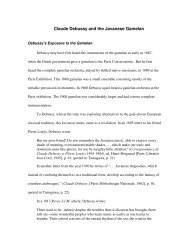Music Preference 1 - Brent Hugh's personal and business web pages
Music Preference 1 - Brent Hugh's personal and business web pages
Music Preference 1 - Brent Hugh's personal and business web pages
Create successful ePaper yourself
Turn your PDF publications into a flip-book with our unique Google optimized e-Paper software.
<strong>Music</strong> <strong>Preference</strong> 52<br />
1. A study with perhaps 1000-1500 subjects evenly distributed across four different age<br />
groups would confirm or refute the hypothesis that the impressionable years model of music<br />
preference applies to the general school-age population.<br />
2. A study could further explore the interaction between the attitudes of different age groups<br />
towards the informational presentations <strong>and</strong> strength of music preference in different age groups.<br />
The survey used in this study was not specifically designed to explore this interaction. In<br />
addition to music preference questions such as those asked in this study, survey questions could<br />
ask audience members to rate their enjoyment of the informational presentations, to indicate<br />
whether the presentations were to simple or too complicated, <strong>and</strong> to indicate whether the<br />
presentations were too long or too short.<br />
3. Further study could explore the relationship between the audience's social connection<br />
with the performer <strong>and</strong> the effect of the informational presentations on their musical preferences.<br />
A survey question asking whether audience members are related to the performer or whether<br />
they know the performer socially would allow this relationship to be studied.<br />
4. Research could explore further the hypotheses about music attitude <strong>and</strong> learning<br />
suggested by the neural network model of learning <strong>and</strong> by simulated annealing. Experiments<br />
could test the relationships among the relevant variables: (a) a slower hardening of musical<br />
opinion, (b) broader interest in <strong>and</strong> knowledge of music, (c) more detailed <strong>and</strong> accurate<br />
knowledge <strong>and</strong> underst<strong>and</strong>ing of music, <strong>and</strong> (d) more refined taste in music. Audience members<br />
age 20-40 (or perhaps 15-40) would make ideal c<strong>and</strong>idates for such a study, since measuring the<br />
changeability of these audience members' musical opinions would easily discriminate between<br />
those with set opinions (impressionable years model) <strong>and</strong> whose opinions are not yet hardened<br />
(aging stability model). If the predictions of the simulated annealing model of learning are





